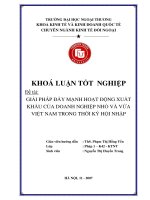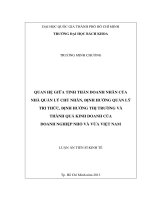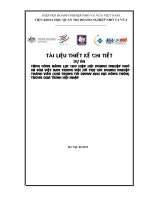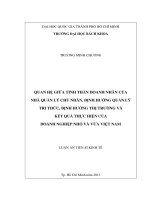Vai trò của nhà nước đối với năng lực cạnh tranh của doanh nghiệp nhỏ và vừa việt nam trong hội nhập kinh tế quốc tế TT TIENG ANH
Bạn đang xem bản rút gọn của tài liệu. Xem và tải ngay bản đầy đủ của tài liệu tại đây (392.64 KB, 27 trang )
VIETNAM ACADEMY OF SOCIAL SCIENCE
GRADUATE ACADEMY OF SOCIAL SCIENCE
NGUYEN THI TUYET NHUNG
THE ROLE OF THE STATE TO THE COMPETITIVE
COMPETENCE OF VIETNAMESE SMALL AND
MEDIUM ENTERPRISES IN INTERNATIONAL
ECONOMIC INTEGRATION
Major: International economy
Major code: 9.31.01.06
SUMMARY OF THESIS THESIS OF
INTERNATIONAL ECONOMY
HANOI - 2021
The work is completed at:
VIETNAM GRADUATE ACADEMY OF SOCIAL SCIENCES
ACADEMIC SUPERVISORS:
1. Assoc. Prof., Dr. Nguyen An Ha
2. Assoc. Prof., Dr. Trang Thi Tuyet
1st defence: Prof., Dr. Do Duc Binh
2nd defence: Assoc. Prof., Dr. Trinh Thi Thanh Thuy
3rd defence: Assoc. Prof., Dr. Nguyen Thi Hong Nhung
The thesis will be defended in front of the Academy-level Thesis
Assessment
Council
at………………………………………………..
Thesis can be found at:
National Library of Vietnam
Library of the Academy of Social Sciences
PREFACE
1. Necessity of the topic research
The role of the state has a great impact to the competitive competence of
SMEs in the international economic integration because of SMEs are the
subject of state management. Management policies and methods direct
influence to the birth, existence and development of SMEs. SMEs can
lose in the domestic market if the competitive competence of Vietnamese
SMEs is weak. Self-managing risks and improving competitiveness in the
context of integration for Vietnamese SMEs is not easy so the role of
State needs to improve the competitiveness of SMEs.
The state must change and reform management in many economic
fields. The view of the Government has also been changed from a by
administrative orders to a governane governing Government that creates
and serves to create an environment and favorable conditions for all
economic sectors, especially those who are economically
disadvantaged. In the private sector, people from all walks of life
promote all development potentials to bring Vietnam's economy to a
new height in integration. The behavior of the State to the SME system
is also towards a supportive management. The Vietnam State has
changed its stance and attitude towards the SMEs, however, the views
and policies haven issued not effeced yet. In the past time, despite
having given support and incentives to SMEs, it has not been effective
in the implementation stage, has not been synchronized, methodical and
has not properly identified the focus on competitiveness of SMEs in the
international economic integration.
The competitive competence of SMEs is directly related to the strength
of the economy, so in order to improve the quality of growth,
productivity and the competitiveness of the economy, it is necessary to
improve the competitiveness of SMEs. Therefore, the State needs to
play its role to SMEs to improve weaknesses, avoid risks, and turn
1
threats and challenges into opportunities for SMEs so that SMEs can be
stronger in the context of globalization.
The role of the State needs to appropriate to the commitments signed in
bilateral and multilateral agreements while still taking advantage of
national competitive advantages, advantages of localities, and SMEs.
Realizing the urgent reasons mentioned above, I chose the topic: "The
role of the state to the competitive competence of Vietnamese small and
medium enterprises in international economic integration"
2. Research objectives and tasks
2.1 Objectives
Building theories of the state's role to the competitive competence of
SMEs; research State the existing problems when the State manage
SMEs in the international economic integration; Proposing solutions for
the State to promote its role in the competitive competence of SMEs.
2.2. Mission
Review of documents and scientific works; Research theories on the
role of the state in the period when the domestic economy integrates
with the international economy to write a theoretical framework for the
role of the state in the competitive competence of SMEs; Learn and
evaluate the reality of the role of the State in the competitive
competence of SMEs in Vietnam. Synthesize and analyze survey data,
run and analyze according to models. Pointing out the impact and
existence of the State's role in the competitive competence of SMEs;
Proposing groups of solutions for the state to improve its role in the
competitive competence of SMEs.
3. Research scope
3.1. Scope of content: The role of the state, the focus is on the
supporting role of the State for the competitive competence of SMEs in
the international economic integration;
2
3.2. Spatial scope: Select SMEs in Hanoi and Ho Chi Minh City for
sampling because Hanoi and Ho Chi Minh city are the two largest
economic centers in Vietnam and have the largest concentration of SMEs;
3.3. Scope of time: The thesis studies from 2009-2020.
4. Research method of the thesis
Methods of sociological investigation to get primary information;
Methods of synthesis and analysis; Quantitative method with data
processing tool used is SPSS software with tools such as: Cronbach's
Alpha coefficient analysis of variance; correlation and regression
analysis...; Collecting secondary information on data and figures from
state management agencies in various fields; Classification and
systematization of theories to synthesize theories of competitive
competence of SMEs in international economic integration, theory of
the role of the state in competitive competence of SMEs...; Method of
quoting legal documents, policies of Vietnam, provisions in
international trade agreements.
Scientific hypothesis and research questions
Scientific hypothesis
The role of the state affects the competitiveness of SMEs in international
economic integration. Although the State and SMEs are two independent
entities in the economy, they have a close relationship and mutual
influence. The State properly and well performs its role in the right
direction of proper, appropriate and effective management, supporting the
positive impact with the competitive competence of SMEs.
Research questions
- How is the relationship between the state's role to competitive in
international integration?
3
- Does international economic integration create advantages and
disadvantages for the State when performing its role in improving the
competitive competence of SMEs?
- What content should the State focus on to improve the competitive
competence of SMEs?
- What is the role of the State in an economy ingeneral and to SMEs
inparticular? How does the level of State support to affect the
competitive competence of SMEs?
- How is the competitive competence of Vietnamese SMEs today?
What factors have SMEs prepared to improve competitiveness?
- What does the State needs to be done to improve the competitiveness
of SMEs in international economic integration, improve the position of
Vietnamese SMEs in the international market?
- How can SMEs take advantage of opportunities and cope with
challenges in economic integration?
- What solutions does the State need to chose to promote supportive
policy solutions to improve the competitive competence of SMEs in
international economic integration?
5. New scientific contributions of the thesis
Theoretically: Inheriting the science of state management for
enterprises, the thesis has theoretically contributed to the role of the
state in the competitive competence of SMEs in the international
economic integration;
In practical terms: the proposed solutions are applicable in the state
management to SMEs in the Vietnam's integration with the aim of
improving the competitive competence of SMEs.
6. Theoretical and practical significance of the thesis
4
The thesis uses methods of analysis and interpretation to systematize the
theory of competitive competence of SMEs; theoretically systematize the
role of the State in the competitive competence of SMEs.
Studying the current state of the competitive competence of SMEs, the
status of the state's role to the competitive competence of SMEs, the
actual implementation of the State's policies to support SMEs in recent
years, the thesis proposes possible solutions.
7. Structure of the thesis
Chapter 1. Overview of research related to the topic
Chapter 2. Theoretical and practical basis for the role of the state to the
competitive competence of small and medium enterprises in
international economic integration
Chapter 3. The reality of the state's role to the competitive competence
of small and medium enterprises in international economic integration
in Vietnam
Chapter 4. Some solutions to promote the role of the state to the
competitive competence of SMEs in international economic integration
5
CHAPTER 1
OVERVIEW OF RESEARCH SITUATION RELATED
TO THE TOPIC
1.1. Overview of domestic studies
1.1.1. Studies on the role of the state in SMEs
There are many studies on the role of the state through promulgating
supportive policies for SMEs in the fields of trade, investment, labor
resources, tax... There are research directions on enterprise protection.
shared. There is a direction to study SME development policies in other
countries and draw lessons for Vietnam.
1.1.2. Studies on the Competitiveness of SMEs
Research on competitive competence of SMEs in specific areas such as
Pham Thu Huong with the thesis "Competitive competence of small and
medium-sized enterprises, research in Hanoi city", some other
researchers have studied a number of factor such as the competitive
competence of SMEs, human resource development of Le Thi My Linh,
finance of Tran Thi Thanh Tu and Dinh Thi Thanh Van.
1.2. Foreign studies
Charles Harvie and Boon- Chye Lee (2002), The Role of SMEs in
National Economies in East Asia, focusing on the SME sector of some
East Asian economies; Robert McIntyre, The Role of Small and Medium
Enterprises in Transition: Growth and Entrepreneurship mainly studies
the role of SMEs in transformation; Dobeš Kamil, Kot Sebastian,
Kramoliš Jan, Sopková Gabriela in the study The Perception of
Governmental Support in The Context of Competitiveness of SMEs in
the Czech Republic, demonstrating that the business environment
affects the performance of SMEs and also the perception of the
Government support in SME competition.
6
Other studies in the direction of capital research, the reform of SMEs,
which integrate the study of the State's policies for SMEs.
1.3. Successes, unresearched gaps and research directions of the thesis
1.3.1. The successes of the research
Forming a theoretical framework for competitive competence of SMEs,
focusing on internal factors of competence: finance, human resources,
science and technology; Theoretical studies on the role of the state are
mainly reflected in the promulgation of SME development policies,
including contents that demonstrate the importance of solutions to
support SMEs, create an environment business, macroeconomic
stability for the overall development of the economy.
Practical studies mainly refer to the practices of competitiveness of
SMEs and the practice of state support for some SMEs, specifically
finance, R&D research, etc.
Regarding solutions to improve the role of the state to develop SMEs,
there are somes research works that have proposed specific solutions for
the state to support SMEs in finance, capital and technology, and human
resource training. , creating a business environment for SMEs..
1.3.2. Unresearched gaps
There has not been any research on the role of the state to the
competitive competence of SMEs in international economic integration.
1.3.3. Research direction of the thesis
- Theory of the role of the state to the competitive competence of SMEs
- The reality of the state's role to the competitive competence of SMEs
in international economic integration in Vietnam
- Solutions to promote the role of the state to improve the
competitiveness of SMEs in international economic integration.
7
CHAPTER 2
THEORETICAL, PRACTICAL BASIS ON THE ROLE OF THE
STATE TO THE COMPETITIVE COMPETITION OF SMALL
AND MEDIUM-MEDIUM ENTERPRISES IN INTERNATIONAL
ECONOMIC INTEGRATION
2.1. Competitive competence of small and medium enterprises in
international economic integration
2.1.1. The concept of competitive competence of enterprises
2.1.2. Criteria for evaluating competitiveness of enterprises
Based on Michael Porter's diamond model, the criteria for evaluating
competitiveness of enterprises will be influenced by four groups of
factors including: (1) conditions of production factors; (2) condition of
demand; (3) supporting industries; (4) strategy, structure of enterprises
and competitive environment.
2.2.1. The concept of competitive competence of SMEs
2.2.1.1. SMEs, characteristics and roles
According to small and medium-sized enterprises, the classification is
usually only relative and different countries have different norms
because it depends on many factors such as the level of economic
development of the country, characteristics of industries, territories,
history, classification purposes. SMEs play an important role in the
economy such as creating jobs, taking advantage of resources, meeting
needs...
2.2.1.2. The concept of competitive competence of small and medium
enterprises
The competitiveness of SMEs is the ability to take advantage of inside
factors of the enterprise (with core high use value products) combined
with the application of outside factors of the enterprise to create a
8
higher advantage (create high value products which bring comparable
benefits) to overtake competitors in the market and make sustainable
development in the context of international economic integration.
2.2.2. Criteria for assessing competitive competence of small and
medium enterprises in international economic integration
2.2.2.1. Factors in the internal environment of SMEs: (i) Elements of
organizational and management qualifications; (ii) Labor qualification,
financial capacity, equipment level, technology level, marketing
qualification; (iii) Prestige and brand; (iv) Ability to link and cooperate
with other enterprises and international economic cooperation.
2.2.2.2. Factors in the external environment of SMEs
(i) Macro-environmental factors: Synthesized from the PEST method,
GCI, and Michael Porter's diamond model, the factors affecting the
competitiveness of SMEs are: Conditions of production factors;
Demand conditions; Supporting industries and related industries;
government influence; opportunity; business environment…
(ii) Micro-environmental factors: Competitors are the factors that have the
most direct impact on the ability of enterprises to maintain their position.
2.3. The role of the state in international economic integration
2.3.1. The role of the state changes for SMEs in international economic
integration
The role of the state changes in international economic integration that
manages the SME changed. There has been got directly intervention to
the business process of enterprises. The constructive government will
have macro mechanisms and policies; Enterprise support policies;
Promote business activities of enterprises.
2.3.2. The role of the state to the competitiveness of SMEs
9
The role of the state to the competitive competence of SMEs means that
the state implements the most optimal measures to affect the internal
and external factors of SMEs that create the competitive competence of
SMEs so that those factors create advantages and increase superiority
for SMEs to develope sustainably in international economic integration.
SMEs with its own characteristics face to challenges, the state orients
the operation of SMEs by institutions, mechanisms and policies for
socio-economic development; creating an environment for production
and business activities; inspection and supervision of production and
business activities should correspond to the characteristics of SMEs and
integration conditions, and at the same time protect SMEs.
2.3.3. Creating sinstitutions and policies for SMEs
Creating institutions and policies suitable to the context of international
economic integration; Protect SMEs; Improve business environment
index, national competitiveness.
2.4. Supporting small and medium enterprises in line with
international commitments
These supports do not violate the international commitments that the
country is a signatory to, for example: in Chapter 24 of the CPTPP
Agreement, there are specific regulations for SMEs. The state in
integration has increased the power of the state in some aspects, but
with a new minds that the state must be a state of development, serving
the society, people and businesses without violating market rules and
“common rules of the game”.
2.5. Applicable principles
2.5.1. Place small and medium enterprises in the chain of the global
economic
SMEs will be able to participate in global value chains and short supply
chains, thereby gaining many economic and branding benefits for
10
businesses, that will affect to factors of the internal environment of
SMEs (expand the scope of business activities ; taking advantage of
investment sources to improve financial capacity; improve production
capacity; apply technology; improve skills; improve product quality...).
2.5.2. Harmonizing with the way of associations and unions work
Creating a favorable mechanism for the establishment of associations
and unions so that the protection of SMEs in integration is more
proactive and closely addresses the practical needs of SMEs.
2.5.3. Applicating to international standards and cross-border standards
on the entire process for small and medium enterprises
In order to make SMEs to operate locally but with a global mindset, it is
necessary for the state to have regulatory frameworks on enterprise
standards, for output goods of ISO quality, for transparency in finance,
etc. SMEs apply standards The sooner the SME will be more stable
when integrating into the international market.
2.5.4. Apply maximum market rule and limit direct to SME
operations
Intervention of Government to the production and business activities of
SMEs is not appropriate. Giving the right to lead the market to a market
actor will easily lead to inequality in production and business activities.
2.6. Some criteria to evaluate the role of the state
2.6.1. The set of criteria for assessing the national business
environment, national competitiveness
The Business Environment Index mainly refers to regulations, legal
frameworks, administrative procedures, and technical obstacles related
to the operation of domestic SMEs. Based on this report, it is possible to
assess the impact of state tools and procedures on SMEs. National
competitiveness is assessed by the GCI index, which includes factors in
11
group 1 of institutional assessment, macroeconomic stability, and
infrastructure created by state management.
2.6.2. The set of indicators for assessing the competitiveness of
localities and agencies of sector management
The indicators to evaluate the competitiveness of the locality, selected
by the agency in charge of the field within each country. In Vietnam,
there are indicators such as PCI, MEI, and PAPI to assess the positivity
and initiative of the State apparatus to change to better suit the needs
and improve the confidence of enterprises.
2.7. International experience on the role of the state to the
competitiveness of SMEs and lessons for Vietnam
2.7.1. Japanese experience
Japan's SME development policy focuses on promoting the growth and
development of commercial SMEs; enhance the socio-economic
benefits of enterprises; overcome the disadvantages that commercial
SMEs encounter; support the self-reliance of SMEs.
2.7.2. Korean experience
Due to export-led growth, Korea has introduced policies to support export
promotion, support the development of foreign market information and
research services, and seek trade and product promotion opportunities.
Korea in the overseas market. Providing “globalization services”,
supporting SMEs to develop in export markets.
2.7.3. Lessons for Vietnam
Lessons from Japan, the role of the state in strategic planning and
development always have a rightful place for small businesses.
The lessons from Korea is to provide the most optimal tools for SMEs
to participate in the global playing field
12
CHAPTER 3
THE SITUATION OF THE STATE ROLE FOR COMPETITIVE
COMPETITION OF SMALL AND MEDIUM-SIZED
ENTERPRISES IN INTERNATIONAL ECONOMIC
COOPERATION IN VIETNAM
3.1. Situation of competitive competence of Vietnamese SMEs in
international economic integration
3.1.1. The preparation of competitive factors of SMEs
3.1.1.1. Statistics describing the preparation of external factors
External factors belong to the macro factors related to the input of
SMEs: material-technical infrastructure, administrative infrastructure,
human resources, technological infrastructure, financial market.
Demand conditions, supply sectors and related industries.
3.1.1.2. Descriptive statistics of the preparation of internal factors
The preparation for the following factors: Organizational management
level, labor level, financial ability, ability to cooperate, science and
technology level, marketing ability of SMEs.
3.1.1.3. Analyze the reliability of each scale of independent variables internal factors, external factors. Cronbach'Alpha coefficient is used to
analyze the reliability for each observed variable. Cronbach (1951)
gives the reliability coefficient for the scale. The observed variables are
qualified and reliability.
3.1.2.1. Descriptive statistics on competitive competence of SMEs
The competitive competence of SMEs is assessed by the preparation of
internal and external factors of SMEs, there are 6 dependent variables: Level
of organization and management of enterprises (NL1); Enterprise resources
(NL2); Product's competitiveness (NL3); Ability to link and cooperate with
other enterprises and international economic integration (NL4); Business
productivity (NL5); Reputation, brand of the enterprise (NL6).
3.1.2.2. Analyze the reliability of the scale
13
Considering the columns representing Cronbach's Alpha-if Item Deleted
value is less than the Cronbach Alpha and Corrected Item coefficients –
Total Correlation is greater than 0.3 and less than the Cronbach Alpha
value of the group, so the variables are all valid.
3.1.2.3. Evaluate two important types of values of the scale
Focus on three main results: KMO and Bartlett's Test, Total Variance
Explained and Rotated Component Matrix to evaluate the appropriate
EFA analysis results, all variables are valid
3.1.2.4. Multivariable linear regression model evaluating the
competitiveness of SMEs shows the correlation between the independent
variables and the competitive competence variable of SMEs.
3.1.2.5. CFA analysis of independent variables affecting the
competitive competence of SMEs shows that the interaction between
the component factors has the same direction with the common factor
with valid results.
3.2. The status of the State's role in the competitive competence of
small and medium-sized enterprises in international economic
integration
3.2.1. Survey on the effectiveness of state support for SMEs
3.2.1.1. Descriptive statistics for the independent variables: (1)
Effectively cutting administrative procedures that hinder production and
business; (2) Effectively support production information; (3) Effectively
supporting innovative start-ups; (4) Effectively support participation in
industry clusters and value chains; (5) Effectively support the
transformation of DN
3.2.1.2. Descriptive Statistics of Dependent Variables Description of the
overall effectiveness of supporting SMEs by the state
.2.1.3. Analyze the reliability of the independent variable scale
14
(1) Effective independent variable to reduce administrative procedures
that hinder production and business; (2) Effective independent variable
to support production and business information; (3) Effective
independent variable to support innovative start-ups; (4) Effective
independent variable supports joining clusters and value chains; (5)
Effective independent variable to support business transformation
3.2.1.4. Reliability analysis of dependent variable scale- Effective
support for SMEs: no variable was excluded.
3.2.1.5. EFA independent variables affect the effectiveness of state
support for SMEs: Focus on three main results tables, namely KMO and
Bartlett's Test, Total Variance Explained and Rotated Component
Matrix to evaluate the appropriate EFA analysis results.
3.2.1.6. The EFA for the dependent variable-Effectiveness of the State's
general support for SMEs shows consistent analytical results.
3.2.1.7. Correlation between the independent variables and the effective
dependent variable to support SMEs: The above correlation coefficient
table shows that the independent variables are not too correlated with
each other. Thus, the multivariable regression analysis is guaranteed.
3.2.1.8. Multivariable linear regression model to evaluate the
effectiveness of the State's support for SMEs
3.2.1.9. CFA analysis of independent variables affecting the
effectiveness of the State's support for SMEs: all indicators are
satisfactory. Thus, the model fits the obtained data.
3.2.1.10. SEM . structural model analysis
15
The results from the SEM model show that: If the support
factor of the state increases, the effectiveness of support for SMEs
increases to a certain number.
Estimate
S.E.
C.R.
P
HIEUQUA
<---
THUTUC
.249
.077
3.243
.001
HIEUQUA
<---
THONGTIN
.217
.068
3.207
.001
HIEUQUA
<---
KHOINGHIEP
.237
.068
3.465
***
HIEUQUA
<---
LIENKET
.152
.069
2.205
.027
HIEUQUA
<---
CHUYENDOI
.230
.065
3.536
***
NANGLUC
<---
BENNGOAI
.484
.052
9.272
***
NANGLUC
<---
BENTRONG
.440
.050
8.888
***
NANGLUC
<---
HIEUQUA
.035
.052
.672
.502
NANGLUC
<---
CHUYENDOI
-.026
.045
-.574
.566
16
Label
Estimate
S.E.
C.R.
P
NANGLUC
<---
LIENKET
-.014
.047
-.286
.775
NANGLUC
<---
KHOINGHIEP
-.042
.048
-.869
.385
NANGLUC
<---
THONGTIN
.019
.047
.403
.687
NANGLUC
<---
THUTUC
-.134
.054
-2.491
.013
TTHC1
<---
THUTUC
1.000
TTHC2
<---
THUTUC
.973
.048
20.397
***
TTHC3
<---
THUTUC
.962
.060
15.987
***
TTHC4
<---
THUTUC
.944
.056
16.745
***
TTHC5
<---
THUTUC
.965
.062
15.647
***
TTHC6
<---
THUTUC
.864
.058
14.935
***
TTHC7
<---
THUTUC
.864
.068
12.706
***
YTBT2
<---
BENTRONG
1.000
YTBT1
<---
BENTRONG
1.034
.033
31.750
***
YTBT3
<---
BENTRONG
.999
.045
22.016
***
YTBT4
<---
BENTRONG
.976
.042
23.126
***
YTBT6
<---
BENTRONG
.959
.054
17.863
***
YTBT5
<---
BENTRONG
.921
.050
18.481
***
NL5
<---
NANGLUC
1.000
NL4
<---
NANGLUC
1.068
.057
18.620
***
NL3
<---
NANGLUC
1.031
.056
18.533
***
NL1
<---
NANGLUC
1.087
.047
23.068
***
NL2
<---
NANGLUC
1.041
.047
21.934
***
NL6
<---
NANGLUC
1.093
.062
17.702
***
TTSXKD1
<---
THONGTIN
1.000
TTSXKD2
<---
THONGTIN
.961
.030
32.559
***
TTSXKD3
<---
THONGTIN
.877
.038
23.290
***
TTSXKD4
<---
THONGTIN
.951
.042
22.839
***
TTSXKD5
<---
THONGTIN
.842
.048
17.565
***
KNST1
<---
KHOINGHIEP
1.000
KNST2
<---
KHOINGHIEP
1.006
.026
37.998
***
KNST3
<---
KHOINGHIEP
.980
.037
26.212
***
KNST5
<---
KHOINGHIEP
.850
.048
17.882
***
KNST4
<---
KHOINGHIEP
.945
.049
19.195
***
17
Label
Estimate
S.E.
C.R.
P
LKNCGT1
<---
LIENKET
1.000
LKNCGT2
<---
LIENKET
1.006
.033
30.704
***
LKNCGT3
<---
LIENKET
.948
.039
24.252
***
LKNCGT4
<---
LIENKET
.872
.048
18.307
***
LKNCGT5
<---
LIENKET
.808
.054
15.075
***
CDDN1
<---
CHUYENDOI
1.000
CDDN2
<---
CHUYENDOI
.927
.026
35.337
***
CDDN3
<---
CHUYENDOI
.898
.035
25.394
***
CDDN4
<---
CHUYENDOI
.818
.041
20.160
***
YTBN1
<---
BENNGOAI
1.000
YTBN2
<---
BENNGOAI
.965
.035
27.328
***
YTBN3
<---
BENNGOAI
.988
.043
22.829
***
YTBN4
<---
BENNGOAI
.996
.046
21.586
***
HQ2
<---
HIEUQUA
1.000
HQ4
<---
HIEUQUA
.991
.048
20.586
***
HQ3
<---
HIEUQUA
.953
.046
20.843
***
HQ1
<---
HIEUQUA
.668
.057
11.662
***
Label
3.2.1.10. The boostrap test shows that the SEM model has practical
significance, explaining the supporting role of the State for SMEs,
specifically testing the research model using the SEM linear structural
model testing technique. 13 hypotheses are accepted. The results of
testing the research hypotheses are summarized in Table.
Regression Weights: (Group number 1 - Default model)
Parameter
SE
SE-SE
Mean
Bias
SE-Bias
C.R
HIEUQUA
<---
THUTUC
0.087
0.002
0.249
0
0.003
0.00
HIEUQUA
<---
THONGTIN
0.072
0.002
0.217
0
0.002
0.00
HIEUQUA
<---
KHOINGHIEP
0.079
0.002
0.238
0
0.002
0.00
HIEUQUA
<---
LIENKET
0.076
0.002
0.153
0.002
0.002
1.00
HIEUQUA
<---
CHUYENDOI
0.074
0.002
0.231
0.002
0.002
1.00
NANGLUC
<---
BENNGOAI
0.062
0.001
0.485
0.002
0.002
1.00
NANGLUC
<---
BENTRONG
0.062
0.001
0.44
0
0.002
0.00
18
NANGLUC
<---
HIEUQUA
0.058
0.001
0.036
0.001
0.002
0.50
NANGLUC
<---
CHUYENDOI
0.047
0.001
-0.025
0.001
0.001
1.00
NANGLUC
<---
LIENKET
0.048
0.001
-0.013
0.001
0.002
0.50
NANGLUC
<---
KHOINGHIEP
0.048
0.001
-0.039
0.003
0.002
1.50
NANGLUC
<---
THONGTIN
0.049
0.001
0.019
0
0.002
0.00
NANGLUC
<---
THUTUC
0.052
0.001
-0.132
0.001
0.002
0.50
3.2.2. Some results the State has achieved for SMEs
3.2.2.1. International Economic Cooperation bring SMEs into the world
market: Developing and promulgating policies to develop and support
SMEs; Protect SMEs; Deploy groups of solutions to support SMEs
3.2.2.2. Improve indicators affecting the competitiveness of SMEs
3.3. Remaining problems
As for the institutional changes, it is not enough to boost the density of
enterprises per population and upgrade the size of enterprises; business
environment, but there have been still many obstacles for the
competitive competence of SMEs; SMEs have difficulties to access
financial support and tax support; There have been regulations and
implementation of financial support for SMEs, but SMEs have been
difficult to access credit sources; Reforming methods, shortening tax
payment procedures helps SMEs somewhat reduce costs, but tax
policies have been still not specific to SMEs.
19
CHAPTER 4
SOLUTIONS TO IMPROVE THE EFFICIENCY OF
IMPLEMENTATION OF THE STATE ROLE FOR
COMPETITIVE COMPETITION OF SMALL AND MEDIUMSIZED ENTERPRISES IN INTERNATIONAL ECONOMIC
INTEGRATION
4.1. International context and domestic context
4.1.1. International context
The US-China trade war is getting more and more intense, the Covid 19
epidemic affects the speed of global trade. Peace, cooperation and
development continue to be the dominant trend in international
relations. The cooperation of countries has been need to solve global
issues.
4.1.3. Challenges for the State and small and medium enterprises in
the coming period
The context of international economic integration has made the state's
economy management role changed. Economic integration has had a
strong impact on the formation of economic development policies of
each country without any distinction in terms of political regime and
development level, so Vietnam need to be proactive to gain the goal of
becoming an industrialized and modernized country.
Keeping the orientation and goals depend on the leaders in the
management apparatus.
4.2. Orientations and goals on demonstrating the role of the State in
the competitive competence of SMEs in the new decade
4.2.1. Orientation
Thinking about competitive competence of SMEs is changed from
internal factors of SMEs to the content of improving the
competitiveness of SMEs in the international economic integration as
part of the socio-economic development strategy
20
4.2.2. Targets
- Improving the competitiveness factors of SMEs in international
economic integration
- Accelerating SME growth steadily in both quantity and quality
- Create favorable conditions for SMEs to participate more deeply in
global value chains, thereby increasing the value of SMEs' products to
meet international standards and compete with products from other
countries in the region and international market.
- Strengthening linkages between SMEs and large enterprises and
foreign-invested enterprises.
4.3. Solutions for the role of the state in the competitive competence
of SMEs to be effective in international economic integration
4.3.1. Institutional reform has been continued in line with the market
economy, creating favorable conditions to support the competitiveness
of SMEs
- Studying the contents of new-style agreements to reform institutions,
creating environment and policies in line with the contents of the
agreements.
- Legalize the conversion of all business households into enterprises
- Amending and supplementing the Law on Supporting Small and
Medium Enterprises
- Completing and unifying interdisciplinary legal regulations
- Remove the "beg-give" mechanism in the legal regulations
- Transparency of business regulations for enterprises
4.3.2. Develop solutions to support competitive factors of small and
medium-sized enterprises more specifically and effectively
- Continuing to improve credit access support for SMEs by the
introduction of a set of SME credit rating criteria.
21
- Localities that focus on the right SMEs are supported by reviewing
general support programs, local specific support programs, and
grouping businesses by industry and size for appropriate support.
- Tax support solutions for SMEs
- Supplementing human resource training policies for SMEs are more
suitable to the needs of enterprises and suitable to the context of
integration
- Continue to review to reduce and simplify administrative procedures
- Transparency of information in all areas and consulting for SMEs
- Completing regulations on sets of standards, regulations, techniques
and measurements for start-ups, innovative and creative enterprises
- Promulgate economic policies for cooperation and association
between SMEs, large enterprises, and FDI enterprises.
- To help SMEs to protect their reputation and brand
- Promoting to expand the market.
4.3.3. To help SMEs to overcome difficulties, restore and develop
production and business
There are immediate solutions to help SMEs suffer great losses,
especially those deeply involved in production networks and global
value chains that face "double difficulties" (shortage of input materials;
sharply reduce the output market for goods consumption and export) to
stabilize production, business and development.
22
CONCLUDE
The process of international economic integration poses strict
requirements to improve the competitiveness of enterprises in general
and SMEs in particular. Vietnamese enterprises need to quickly and
urgently promote internal resources and seize opportunities to improve
competitiveness.
Moreover,
improving
the
competitiveness
of
enterprises is a regular and continuous process, requiring enterprises to
continuously exploit potentials and advantages, take advantage of
opportunities for business, and constantly increase productivity and
quality. product…
The competitive competence of SMEs has been influenced by the state
management. The difficulties that SMEs are facing come from the
internal factors.
There are many difficulties come from objective
reasons, coming from state management activities. The Stat has the
necessary and timely supports. Implement macro solutions such as:
Forming new policies, perfecting the Law and proposed policies,
developing infrastructure to support production and business of
enterprises, creating a fair competitive environment equality, promoting
the role of SMEs ... or solutions to support immediate difficulties such
as: Financial support, technology innovation support and intellectual
property
protection,
market
expansion
promotion
activities
…Implementing solutions synchronously will help this business sector
to develop its full potential, to develop sustainably and make an
increasingly important contribution to Vietnam's economic cause.
The support of the State in each group and each criterion has a
great impact on the competitive competence of SMEs, which has been
23









